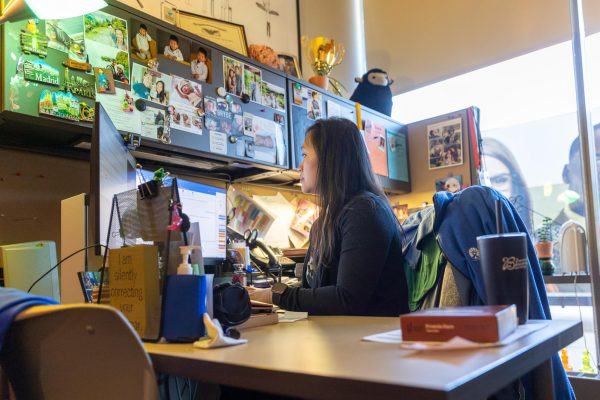“…Live for that feeling:” A night of art and music at Pink Slip Zine’s Issue 003 Release Party
February 12, 2023
Walking up the icy sidewalk parallel to South Spring Street in Downtown Elgin, eager fans, music fanatics and art consumers make their way to Side Street Studio Arts, the place “where Elgin creates.” As people make their way up the black staircase to the second story of the studio, the blissful noise of laughing and conversation fills the air as soft, orange fluorescent lights reflect off the wooden floor, bringing a calming nature to the atmosphere.
Fans of the burgeoning Elgin music and art scene congregated at Side Street Studio Arts in Downtown Elgin to be a part of Pink Slip Zine’s Issue 003 Release Party, which took place on Feb. 11, 2023.
The release party was presented by Pink Slip and Side Street Studio Arts, including live music from bands, Inpo, La Rosa Noir, and Ovarian Cystas, and featured visual art from the artists Atoi Glennette, Jose Manuel Inkster, Christopher Taylor and Natalie Frentes-Aleman.
Pink Slip Zine, which has been operating for about a year and a half, has its roots in Chicago and its suburbs and looks to shine a light on any type of artists who don’t get the recognition they deserve.
Zines, shortened from the word “fanzines,” are independent, small circulated publications that highlight and put out original images and texts. The format of zines varies, differing between homemade book-type “pamphlets” to an actual magazine format.
The art of zine-making has been around since the 1930s, then affiliated with science fiction writing, to the affiliation of punk rock in the 70s and 80s.
Co-editor and Chief of Pink Slip, Skylar Moore, talks about the goals of the zine and brings up the payoff at the end of the publication journey.
“[Pink Slip] is a place for people who don’t normally have access to be published in print; to have their work featured,” Moore said. “We particularly like to spotlight people whose voices are more marginalized, those who are more at the outskirts of society, [and] people who don’t have access to resources. We have so many people who, you know, message us or get the zine in their hand and they’re like, ‘This is so exciting! I’ve never been in a magazine before!’ So we just live for that feeling.”
Moore went further to describe how technology has changed the way people consume art
“I think technology has changed so much in the past, and […] I’m someone who grew up with social media and technology and everything like that, and it has really changed how we exchange information and how we receive content as viewers too,” Moore said. “[…] I love art and I feel like a big place where people go to consume art nowadays is social media, which is totally valid and so many people get recognized and have a platform, but at the same time, it can be counterproductive, because you receive so much content in your day it doesn’t stick.”
To her, zines are concrete, physical evidence of something special to remember and look back at.
“[…] I think zines are important because they provide documentation, a memory, something you can hold in your hands and go back to again and again.”

















